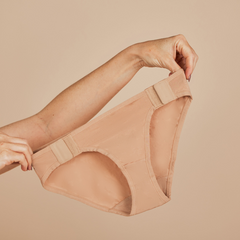
This is not meant to be medical advice, please consult your clinician.
Like any expecting mother, you might experience back pain, fatigue, and swelling during pregnancy.
Hormonal changes naturally loosen your ligaments to prepare your body for birth, but women with Ehlers-Danlos Syndrome and pregnancy can have more pronounced joint discomfort or pain among other complications.
Joint Instability and Pain
If you have hypermobile EDS (hEDS), you may already be familiar with joint hypermobility and instability.
During pregnancy, the increase in relaxin (a hormone that loosens ligaments) can further affect joint stability, particularly in your hips, knees, and lower back.
As your pregnancy progresses, the extra weight can put additional strain on these joints, which might limit your mobility.
It’s essential to work with your healthcare provider to create a plan that includes gentle exercises, like swimming or prenatal yoga, to keep your joints as stable as possible while relieving some of the discomfort.

Managing Chronic Pain and Fatigue
Managing chronic pain and fatigue during pregnancy requires a personalized approach, your usual pain management strategies might need to be adjusted.
Non-pharmaceutical treatments like physical therapy, prenatal yoga, restorative exercises and rest can help you manage pain and fatigue without affecting your baby’s development.
Fragile Skin and Scarring
If your type of Ehlers-Danlos Syndrome affects your skin’s elasticity, it will be more prone to scarring or tearing, especially during childbirth.
You can care for your skin by using gentle, hydrating moisturizers, staying hydrated, and using sunscreen to protect your skin from damage.
Wearing compression garments can also offer support to sensitive areas.
Increased Risks in Vascular EDS
If you have vascular Ehlers-Danlos Syndrome (vEDS), pregnancy may present some higher risks due to the fragility of your blood vessels.
Pregnancy naturally increases the strain on your cardiovascular system, which can increase the risk of complications like arterial rupture or uterine rupture.
However, with careful monitoring and regular checkups, many of these risks can be managed effectively.
Your healthcare team may suggest low-impact exercises like walking or swimming, and stress-reduction techniques such as meditation or prenatal yoga to help you stay healthy during pregnancy.
Adequate rest is also crucial to ensure your body is supported throughout this time.

Postpartum Care
After delivery, it’s important to stay in close contact with your healthcare team to reduce the risk of postpartum complications.
Also you may experience pelvic floor dysfunction or incontinence. Many women with Ehlers-Danlos Syndrome and pregnancy benefit from pelvic floor therapy.
Conclusion
By understanding how Ehlers-Danlos Syndrome and pregnancy affect your body and working closely with your healthcare team, you can navigate pregnancy confidently and embrace the journey to motherhood.
Remember, it’s always best to consult with your healthcare provider for personalized advice and treatment options



